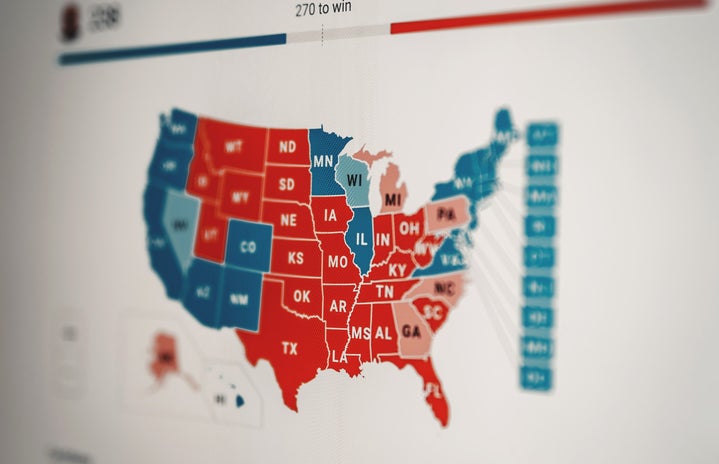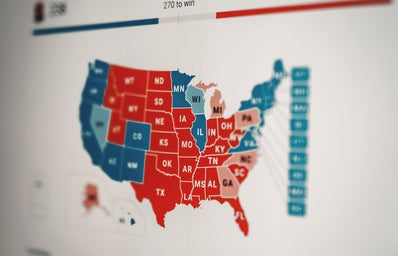As I am sure everyone is aware, Tuesday, November 3rd was election day. The presidential election between President Donald Trump and former Vice President Joe Biden has been a truly historic one, and it would finally come to an end on Tuesday…or so we thought. In truth, the increased amount of mail-in ballots made the counting process for states a lot harder this election season, and we did not find out the results until Saturday, November 7th. News networks, such as MSNBC, provided non-stop coverage for days on end. Big shoutout to Steve Kornacki, who was only off our screens for 6 hours total out of all four days. If you aren’t a Government student who was completely obsessed with the election, you may have missed some important moments. Luckily, this article will help fill you in on what exactly happened and how during these historic past four days.
7 p.m. on Election Night
At 7pm, only Indiana was able to call their race for Donald Trump. This was not a surprise, and it put the official electorate vote count at 11-0 Trump. The news anchors on NBC were showing plenty of scenarios with the swing states, which just makes it more clear that this election really could go to anyone. Around 7:15, another unsurprising call, Vermont went to Biden, giving him 3 electorate votes. The 7:30 poll closings brought North Carolina, Ohio, and West Virginia, which were all too early to call right as they closed. The NBC news anchors broke down the counties in Florida and how the night could play out, but noting that it could take a long time to call the Florida race. It sounds like Florida’s Miami-Dade county will play a huge role in who will eventually win the state. Popularity with Cuban-American voters and Venezuelan-American voters is the key to which candidate will snag Miami-Dade. At 8pm, Kentucky was called for Donald Trump.
8 p.m. on Election Night
A large handful of poll closings came in at 8, including Florida, Pennsylvania, and our very own Connecticut. Florida was reported as too close to call, with Mississippi, Maine, Alabama, and Missouri being too early to call. Biden picked up D.C, New Jersey, Massachusetts, Maryland, and his home state of Delaware. Oklahoma goes to Trump. While it was still too early to call, Biden was reported as leading in Rhode Island, Illinois and Connecticut and Trump was leading in Tennessee. This puts the count at Biden 44 to Trump 26. At around 8:20, West Virginia was called for Donald Trump, which was expected, and Connecticut went to Joe Biden. This puts the count at Biden 51 to Trump 42. Arkansas polls which closed at 8:30 was too early to call. Virginia was called for Biden around 8:45. This was actually a bit of a surprise. At 8:50, Arkansas was called for Trump.
9 p.m. on Election Night
At 9pm, 14 states closed their polls. Texas, Arizona, Michigan, Minnesota, Wisconsin, Kansas, Nebraska, New Mexico, and North Dakota were all too early to call. Colorado and Louisiana were too early to call but leaning Biden, while South Dakota and Wyoming were too early to call but leaning Trump. New York went to Joe Biden, which was not a surprise. At 9:20, Colorado was officially called for Biden, while South Dakota went to Trump. At 9:30, South Carolina, Alabama, and North Dakota went to Trump. Trump started leading in Florida, which changed the news anchors’ demeanors a little bit. Everyone in the NBC studio got a little bit more serious as votes for Trump climbed.
10 p.m. on Election Night
At 10pm, New Mexico was called for Biden, while Kansas went to Trump. Many states with polls closing at 10 were too early to call. Trump was leading in PA, MI, WI, FL, GA, LA and NC, with Biden leading AZ and MN. However, most of these states had less than 50% of the vote in which made it likely that there would be a lot more movement. Louisiana went to Trump at 10:30. This makes the electorate count Biden 131 to Trump 98. Just after 10:30, Trump picked up Utah and Missouri and Biden got Illinois. Also around this time, the news anchors became more optimistic about North Carolina. They noted that a lot of the votes left to count were coming out of blue counties. Trump also picked up Nebraska, Mississippi, and Wyoming.
11 p.m. and Midnight on Election Night
At 11pm, Biden picked up California, Oregon and Washington. It was at this point that NBC took a break to air local CT news, mostly about the local races and Biden’s victory in the state, which was definitely expected. At midnight, NBC called the crucial swing state of Ohio for Donald Trump. After this, things remained stagnant for a few days while the last few remaining states counted their ballots. Steve Kornacki and his Big Board were always there for us to explain when a big batch of votes was put into the system.
The Last Four Days
On Wednesday, Wisconsin and Michigan were called for Biden. This put the count at 253 Biden to 214 Trump. The states remaining were Pennsylvania, Georgia, Nevada, Arizona, North Carolina, and Alaska. Biden would need either Pennsylvania, or a combination of 2 out of Nevada, Arizona, Georgia, and North Carolina. At this point, Trump was ahead in NC, GA, and PA, but as mail-in votes were counted, the difference between the candidates was tightening. Early on Friday morning, it was announced that Biden had passed Trump in Georgia. He had not won the state yet, but a Democratic candidate had not won the state of Georgia since Bill Clinton in 1992, so it was pretty historic. Mid-morning Friday, Biden passed Trump in Pennsylvania, a state Trump had won in 2016. The people of Philadelphia celebrated by dancing in the streets, creating many viral moments. As the margin between Trump and Biden grew, people began to wonder when the race would be called. Votes would be counted for the next few days, but the nation waited in suspense for an announcement when it was clear who would ultimately win. Then,finally, at around 11:30am on Saturday, it was announced: Joe Biden had won Pennsylvania. This put his count at 273, effectively making him the President-elect of the United States, and Kamala Harris is the new Vice President-elect, making her the first woman to be elected to the position and the first Person of Color.



